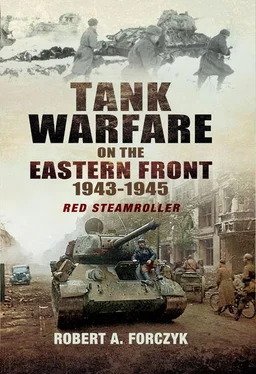Meanwhile Khrustitsky’s T-60 tanks and infantry from the 67th Army continued to press eastward, across terrain that the Tigers could not traverse, toward a link-up with the slowly advancing 2nd Shock Army. For reasons that defy military logic, the German XXVI Armeekorps commander moved a Kampfgruppe Hühner with five Tigers, four Pz III and five StuG III to the town of Shlissel’burg on 16 January, just as the jaws of the two Soviet armies were closing in from both side of the Siniavino corridor. The Germans were desperate to hold a work settlement known as WS-5 that was on a key trail intersection in the middle of the corridor and for two days Kampfgruppe Hühner fended off one attack after another. However, the terrain was perfect for infantry infiltration and the Germans were road-bound, so Kampfgruppe Hühner was gradually isolated and cut off. On the morning of 18 January, the Soviets finally stormed WS-5 and troops from the two fronts linked up at 0930 hours. Khrustitsky’s tiny T-60 tanks were in at the kill; while its 20mm cannon was normally not useful in tank-v-tank combat, it was very effective in destroying the wooden buildings in WS-5. The loss of WS-5 completely cut off the 8,000 troops in Kampfgruppe Hühner, who were now determined to break out to the south before it was too late.
Putting the tanks in the lead, Kampfgruppe Hühner moved south along a trail, through an area consisting of peat bogs and scrub forest. Soviet anti-tank gunners were waiting and they hammered the German armoured column, which could barely move off the road; four Pz IIIs were knocked out and even a Tiger was knocked out by 76.2mm fire. The German column tried to fight its way through the ambush, but the Tigers were hit repeatedly and disabled one by one. Two Tigers were blown up by their crews and another was burning. The last Tiger accidentally drove off the trail into a peat bog and became hopelessly mired. The Germans tried to retrieve this tank or destroy it, but were driven off by Soviet fire. Five of Khrustitsky’s T-60 tanks managed to hook tow cables to the abandoned Tiger and pull it free of the bog – the first intact Tiger captured. Although all five Tigers were lost, most of the troops of Kampfgruppe Hühner were able to escape to the south. By the end of 18 January, Operation Iskra had accomplished its main objective of opening up a land corridor to Leningrad, officially ending the siege.
Unfortunately for the front-line soldiers on both sides, Marshal Zhukov regarded Operation Iskra as an incomplete victory and ordered both the Leningrad and Volkhov Fronts to continue the battle until the high ground around Siniavino was captured. The result was another 10 days of tough fighting with heavy losses on both sides, but the German defences held. The 1./s. Pz. Abt. 502 played a major role in stopping the Soviets from capturing the Siniavino Heights by knocking out 55 enemy tanks, but one Tiger was destroyed in action as well as 12 Pz III tanks. By the time that the battle ended in mutual exhaustion on 31 January, the company had only one operational Pz III and two non-operational Tigers left. {37} Soviet armour losses were also very heavy, with about 200 of 400 tanks knocked out or inoperative. Overall, the battle was a bitter disappointment for the Germans, who lost most of their armour, and 1./s. Pz. Abt. 502 was hors de combat. Furthermore, the captured Tiger would be intensely studied by the Soviets, leading to a decision by the GKO to finally upgrade the firepower of the T-34 and to develop a new heavy tank. Despite their success, the Red Army was not entirely satisfied with the performance of its tank units and the Leningrad Front issued a harsh criticism to the 67th Army on 27 January 1943:
Combat experience from the 67th Army shows that the employment of tank units had major deficiencies that resulted in unjustifiable heavy losses of tanks. Combined-arms commanders introduced tanks into battle too quickly, without taking the necessary time to prepare tanks for battle, or for reconnaissance or for coordination, nor did they use engineers to prepare the routes for tanks. The commanders of [rifle] divisions and regiments did not coordinate their actions with tanks on the battlefield… Tanks rushed at the enemy defences without adequate artillery support and tank units were usually not on the artillery radio net… {38}
Nor was Zhukov done with Heeresgruppe Nord, since he had been working on a plan known as ‘Polar Star’ that was intended as a follow-on to Operation Iskra . His grand plan was that Marshal Semyon Timoshenko’s Northwestern Front would crush the German-held Demyansk salient then coordinate with the Leningrad and Volkhov Fronts to envelope and crush the right flank of Heeresgruppe Nord between them. A new 1st Tank Army, led by one of the most experienced senior Soviet tankers – General-leytenant Mikhail E. Katukov – was formed in the Northwest Front at the end of January 1943. Katukov was given the 3rd Mechanized Corps and 6th Tank Corps and other units for a total of 631 tanks. {39} Zhukov wanted to drop a large force of parachutists behind German lines then have Katukov’s armour punch through the front to relieve them and split open Heeresgruppe Nord’s defences. As often happened with Zhukov’s bold, grand plans, it was more than the Red Army could accomplish and it failed to anticipate enemy actions. Timoshenko’s 1st Shock Army had mounted a powerful but clumsy attack against the Demyansk Salient in early January that had cost it 423 tanks in six weeks and failed to break through. As this offensive was dying down, Zhukov ordered Meretskov’s Volkhov Front to mount a strong fixing attack toward Tosno to prevent Heeresgruppe Nord from shifting reserves to Demyansk. Anticipating this attack, Heeresgruppe Nord moved 1./s. Pz. Abt. 502, which had received three new Tigers, to the Krasny Bor sector on 7 February.
Three days after the Tigers moved by rail, the Soviet 55th Army launched a major attack against the Spanish Blue Division (250.Infanterie-Division) at Krasny Bor. After a massive artillery barrage, the Soviets blasted through the centre of the Spanish division with the 63rd Guards Rifle Division, supported by 21 KV-1 tanks from the 31st Guards Tank Regiment. Although the Spanish defenders managed to knock out four KV-1 tanks, their centre was shattered within two hours and they lost Krasny Bor by the end of the day. It was a significant Soviet victory and the Spanish Division was badly hurt, but the Soviets failed to anticipate that the loss of terrain always provoked a German counter-attack. The 1./s. Pz. Abt. 502 (three Tigers and three Pz III), led by Leutnant Gert Meyer, was attached to a Kampfgruppe from the SS-Polizei Division and ordered to contain the Soviet breakthrough. Unlike the Siniavino sector, the area around Krasny Bor and Mishkino was better suited to the use of heavy tanks since the ground was more solid and flat, with few trees. Attacking into the left flank of the Soviet salient on 11 February, Meyer’s Tigers had a field day and knocked out 32 Soviet tanks. The next day, they knocked out 10 more. Bloodied, the Soviet 55th Army paused its offensive in order to bring up its own armour, then attacked at Mishkino again on 17 February; Leutnant Meyer’s Tigers were occupying hull-down positions and they calmly picked off 10 KV-1 tanks in a matter of minutes. German Panzerjägers also contributed to the slaughter, since they had just received a large shipment of HEAT ammunition (High Explosive Anti-Tank). A Dutch Panzerjäger Kompanie in the SS-Legion Nederland, equipped with 7.5cm Pak 97/38 anti-tank guns, repulsed an attack by the Soviet 124th Tank Brigade and knocked out 19 tanks.
Following the success of Operation Iskra , the Red Army continued to pound on Heeresgruppe Nord throughout the rest of the winter, but without success. Zhukov transferred the 1st Tank Army to Timoshenko’s Northwest Front to use for another offensive against the Demyansk salient – a swampy area that had already proven totally unsuitable for tanks – but the Germans began evacuating the salient on 17 February and completed the operation by early March. Timoshenko was surprised by this German operation and failed to strike them as they were withdrawing; the Stavka decided to transfer Katukov’s 1st Tank Army to the Voronezh Front. Running out of options, Zhukov pressured Meretskov to make one last effort against the Siniavino Heights before the winter ended – a truly futile effort.
Читать дальше








![John Stieber - Against the Odds - Survival on the Russian Front 1944-1945 [2nd Edition]](/books/405234/john-stieber-against-the-odds-survival-on-the-russian-front-1944-1945-2nd-edition-thumb.webp)



